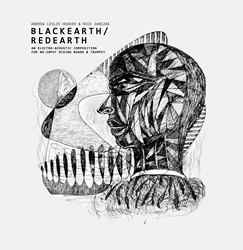 Another electroacoustic collaboration that’s been impressing me lately is Black Earth / Red Earth by composer Andrew Leslie Hooker and trumpeter Nick Janczak. The nature of the collaboration, involving methods being developed as part of Hooker’s ongoing PhD, is interestingly back-and-forth. The starting point comes from an electronic “sound-object” created by Hooker using a no-input mixing board; this is then passed to one or more performers (in this case Janczak) to interpret acoustically. That interpretation is in turn extensively reworked by Hooker to arrive at new version “which the players and composer will ultimately respond to in devising a final score.” i like the multiplicity of this process, and the way it doesn’t just blur but convolutes the distinction between composer and performer, acoustic and electronic, and pre-recorded and live materials. It brings a whole new complexity to the ostensibly simple word ‘electroacoustic’.
Another electroacoustic collaboration that’s been impressing me lately is Black Earth / Red Earth by composer Andrew Leslie Hooker and trumpeter Nick Janczak. The nature of the collaboration, involving methods being developed as part of Hooker’s ongoing PhD, is interestingly back-and-forth. The starting point comes from an electronic “sound-object” created by Hooker using a no-input mixing board; this is then passed to one or more performers (in this case Janczak) to interpret acoustically. That interpretation is in turn extensively reworked by Hooker to arrive at new version “which the players and composer will ultimately respond to in devising a final score.” i like the multiplicity of this process, and the way it doesn’t just blur but convolutes the distinction between composer and performer, acoustic and electronic, and pre-recorded and live materials. It brings a whole new complexity to the ostensibly simple word ‘electroacoustic’.
The intricacy and interpenetration of ideas implied by that description is borne out in the music. In some respects this makes Black Earth / Red Earth a tricky piece to write about; paradoxical too, since one of its most beguiling aspects is its details – both their quality and their quantity – yet those same details are both difficult to describe and, i would argue, of secondary importance to the more generalised behaviour exhibited by the piece. For while Black Earth / Red Earth doesn’t adhere to the kind of model i’ve previously discussed as being a ‘steady state’, it nonetheless displays many similarities to it. Furthermore, this similarity goes beyond just behaviour and also encompasses elements of style and aesthetic, bringing to mind the psychedelic / proto-ambient melding of early ’70s kosmische musik. Echoes of this manifest in the way that Janczak’s melodic meandering (i assume it comes primarily from Janczak) sits at the centre of the music, sometimes in the foreground, sometimes a barely audible undercurrent, its timbre anonymous and subjected to a primitive form of reverb. And while the piece doesn’t enter into the arpeggiations and minimalistic cycles of, say, Tangerine Dream, it does set up a similarly anything-can-happen environment in which slow-moving, quasi-static elements form the backdrop for unpredictable, fast and fleeting surface details. The proximity to a steady state arises primarily from the way that, while the emphasis on its constituent elements keeps changing, overall it remains pretty consistent. There are periods when the energy is pushed, and times when it’s relaxed, but the nature of its narrative could, in essence, carry on forever. The fact that, in this case, Black Earth / Red Earth lasts 37½ minutes is not so much a musical necessity as an incidental artefact of the creative process.
While its palette is relatively well-defined (though it takes a number of listens before this becomes really apparent), the wealth of its details and the way they appear, evolve, develop and / or vanish is endlessly fascinating. There are episodes when pitch predominates, becoming a spine or a foundation for less significant, transitory things happening around or above them. Equally there are episodes when pitch is practically lost as a concept, becoming a texture comprising a welter of pops, burps, squelches and squeals, some of them appearing to bounce and ping pong between the speakers. But most often, these polar ideas mingle, and it’s the balance of them that proves to be one of the most engrossing aspects of Black Earth / Red Earth. They push and pull against each other; one moment we think an idea is going to blossom, but it yields to a network of gentle abrasion, or the plethora of impacts that threaten to take over everything finds itself swept aside due to the soft laser power of dronal pitches. This micro-balance is matched by a macro-balance whereby the piece oscillates between longer periods of activity and repose, over time strengthening that underlying sense of a largely static mode of behaviour.
And on both the large and small scales, all the while it poses the question – which, considering the creative process, may well be unanswerable – regarding to what extent discrete elements and ideas are reacting to, ignoring or existing entirely obliviously to one another. Not only is it impossible to tell, but each successive listen suggests new possibilities of perhaps spurious connection. i think it’s this, above all else, that makes Black Earth / Red Earth such an immersive, mesmeric and – time and time again – rewarding listening experience.
Black Earth / Red Earth is a digital-only release available from the Subcontinental Records Bandcamp site.

Perhaps it’s the brass connection, but what this piece reminds me most of is the Oliveros/Dempster/Panaiotis Deep Listening album. Nothing electro about the acoustic on that, of course, reliant as it was on the Fort Worden Cistern’s 45-second reverb, but there’s the same sense of not being able to tell at any given moment whether you’re listening to the original sound, the echo of that sound or the reaction to that echo.